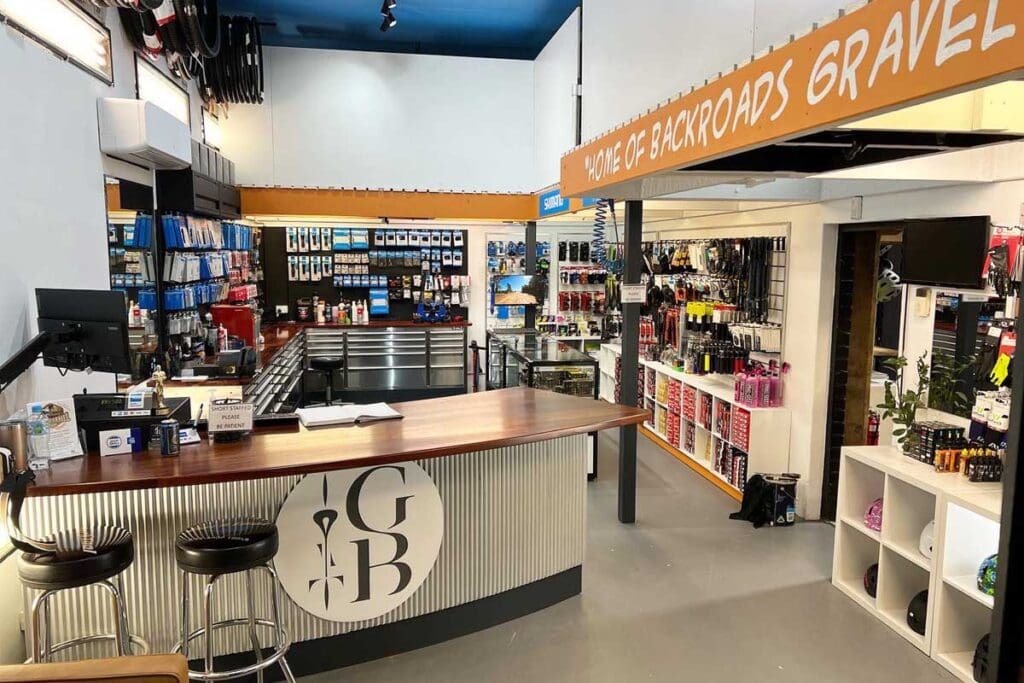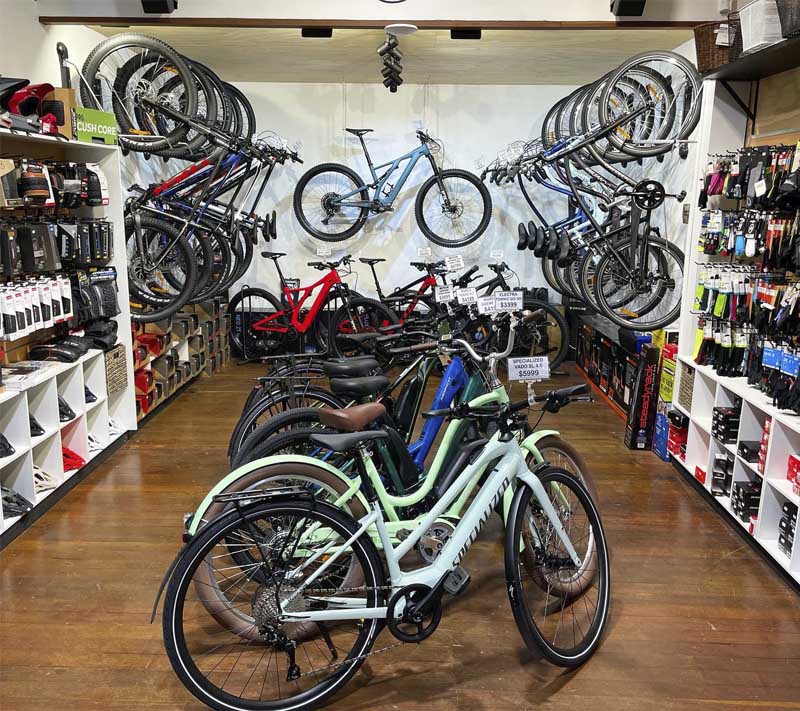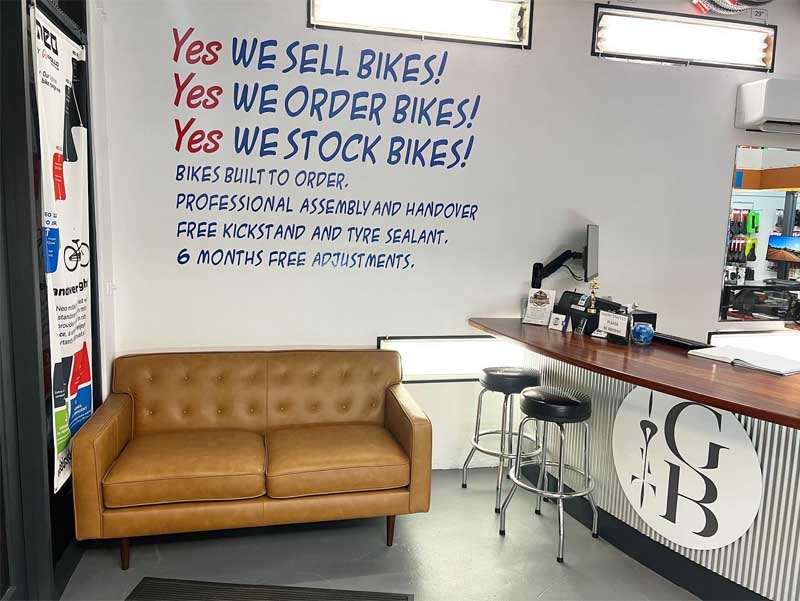Staff-Starved Store Finds Solution as Shop With No Bikes

Geraldton, WA
Northern WA bike store owner Leighton Thomas has received plenty of puzzled expressions in recent weeks, as he outlined plans to reinvent his business as a “bike store with no bikes”.
“I’ve never stumped so many people before,” according to the industry veteran of 33 years, including stints as some of bicycle retail’s leading players.
“They can’t imagine walking into a bike store with no bikes.
“I’ve done a complete 180 degrees from thinking I have to close the shop five weeks ago to thinking I’ve got a very sustainable and profitable business model about to be implemented.”
“Every rep and every other bike person I’ve spoken to about the idea has just been silent for 30 seconds. Then once I walk them through concept and my order and collect process, they say ‘there’s merit in that. I can see the method in the madness’.”
Leighton closed his Geraldton Bikes store for two weeks last month to execute its transformation. When it reopened, floorspace once dedicated to bike displays was now occupied by an expanded workshop, as a central part of his business overhaul.
The transformation was initially a solution to a major staff shortage Leighton was convinced would force him to close the business.
“I’ve done a complete 180 degrees from thinking I have to close the shop five weeks ago to thinking I’ve got a very sustainable and profitable business model about to be implemented,” he said.
In fact, Leighton is confident it will be a future business model for many Australian IBDs.
He says it eliminates substantial overheads, protects them from price fluctuations and discounting, and gives greater flexibility in operating hours to owners and staff can enjoy a better work-life balance.
“We’ve been doing this for years anyway – ordering bikes for customers with specific demands. Nearly 80% of the bikes we’d been selling were on an order basis anyway,” he explained.
“People are coming into the store, walking past $100,000 worth of bikes on display, coming to the counter and saying ‘can you order me a Specialized Stumpjumper in this size, etcetera.
“I thought I’d refine the model even more.”
Leighton said he was forced to reevaluate his business when he lost two staff a few weeks ago.
“Six months ago, I had three senior staff working with me, as well as an after-school kid and two senior staff who were FIFOs (fly in fly out workers who work in blocks of time on remote mining sites but live in Geraldton) who could cover when someone was away.
“I lost the FIFO guys and my other senior staff said they’re going to move on and do other things.”
He said he had exhausted all avenues to find staff. Located 500km north of Perth, Geraldton’s mining operations and the healthy salaries they offered, made it difficult for other industries to attract workers.
“Why would you work here on a certain wage, when you can work at a mine with no real skill set, get trained for free and be on $150,000 a year?” he questioned.

“I couldn’t manage with just me and my main offsider, to cover the sales and repairs. I theorised every possible option, reviewing what I’ve got, what I don’t have and what can I make of this.”
Leighton said his sales were still strong and he had a good list of regular customers.
“You’re getting a click and collect system, but with personalised service all the way through.”
“I thought about what takes up the most time and space, and it’s bike sales. You’re using half your space to keep them on the floor and for a small store like us to keep 70 bikes built and on display is a significant stress on the business.
“I thought maybe I could have something that sits between click and collect and traditional bike retail.”
Leighton said most customers already did extensive research online before making their purchase. His business model put further onus on buys to undertake that online research, while his team could provide complementary advice to help finalise the choice of bike or component.
“You’re getting a click and collect system, but with personalised service all the way through,” he said.
“We will still give advice, including sizing advice. We will build your bike for you, assist you with a handover and provide a free service period as well.
“We’ll look at having a handful of bikes on hand for sizing or a test ride.
“However, now we’re not getting tied up doing 45-minute enquiries for bike sales. Instead, customers could be down to a couple of options. We can run through the things that are important to them, to make the final choice.”
“With the reduced overhead, I’m pretty confident I could run the shop as a workshop that also sells parts and accessories, and the bike sales will be additional cream on the top.”
Leighton compares it to restaurants that only take reservations online. They can enhance their service to patrons in the restaurant because staff time is no longer consumed by taking bookings over the phone or in person.
He said his new business model would hinge on a large and more streamlined workshop, with one third of staff time allocated to bike builds, one third to servicing and repairs and one third engaging with customers for general sales.
“When I read the Latz Report, the general trend seems to be the workshops are always busy and always profitable,” he added.
“With the reduced overhead, I’m pretty confident I could run the shop as a workshop that also sells parts and accessories, and the bike sales will be additional cream on the top.
“I’ve always been focused on being able to turn about repairs in 24 hours, but that brought a lot of stress in having the staff on hand and having the parts available. We’ve now got the confidence to say it’s two or three weeks until we can do your service, and they say, fine, we’ll see you then’.
“We’re still doing on-the-spot repairs. We won’t leave people in the lurch.”
“We receive a bike in a box, then pay to have them assembled, so they now take up twice the space and they’re at risk of getting damaged. How primitive are we?”
Leighton still plans to stock a number of the store’s biggest selling bikes, to help ensure they have bikes ready to build as orders come in and they can be slotted into the workshop schedule – to achieve that two to three-week timeframe. They just won’t be on display.
He was inspired by a nearby Retrovision electrical appliances store, which has much of its stock still in boxes in the showroom.
“They receive their items in a box, display them in a box and put it on the customer to take it out of a box,” he noted.
“We receive a bike in a box, then pay to have them assembled, so they now take up twice the space and they’re at risk of getting damaged. How primitive are we?”
Leighton said his store will aim to two or three builds per day.
“Customers will order a bike, we’ll look at the workshop chart and see when the next available build slot is, and book them in. We’ll contact them when the bike is ready.
“This will also protect me against stocking a bike and then having it drop in price by 40 to 60% … instead, I can move in real time with the market conditions.”
“If the workshop wait time blows out beyond two or three weeks, we won’t even need to stock some bikes because if it takes two weeks for the customer to receive the bike anyway, I might as well just order it from the supplier as the order comes in. It will still arrive before their build slot.

“Obviously there will be some customers that won’t be able to wait for up to two weeks for their new bike. But we’ve built up such a good rapport with our customers and many of them have been waiting that long anyway, so we can apply that to most of bike sales and still sell the same number of bikes.
“It will free up a lot of cashflow and space. This will also protect me against stocking a bike and then having it drop in price by 40 to 60%, leaving me with a bike I paid full price for. Instead, I can move in real time with the market conditions.”
“Bike stores are always treading that line between having enough bikes in stock to get the point across but not having too many, in case they do go on sale.”
Leighton said the ore structured schedule of bike builds and servicing will also help provide a better work-life balance by giving him and his team more opportunity to take holidays – outside key sales periods, of course.
“If you’re a smaller operator, time poor and struggling to go away on holidays, you’re sensitive to staff fluctuations and you want to put yourself in protection model, I think this is a pretty good business model to have.”
“If I go away, there will be a backlog of repairs and builds. My main offsider will have the option of taking time off as well, or working in store for the five days of the week and getting through the backlog.”
Leighton also plans to introduce a charge for bike builds that take longer than two hours.
“Anything beyond that I’m charging the customer labour for that additional time, or the bike brand can credit me the amount for the extra build time. There are now some bikes that are taking six to eight hours to assemble,” he said.
Leighton believes the traditional bike shop model will always be alive and well for big box retailers and well established IBDs that have been doing it for many years.
“But if you’re a smaller operator, time poor and struggling to go away on holidays, you’re sensitive to staff fluctuations and you want to put yourself in protection model, I think this is a pretty good business model to have,” he said.
His new approach will take Leighton back to where he started with Geraldton Bikes, which he created the store a decade ago.
“I was fortunate to work for some great people, in great places and saw many different ways to run a store. It’s inspired my brain to keep thinking if there’s a different way.”
Raised in Geraldton, Leighton did several stints working for bike stores in Sydney and Perth.
That included working at Manly’s Favourite Cycles with Andrew Taylor, as well as with highly accomplished businessman Tony Whiteside at Cyclery Northside and running Bikes R Us at Parramatta in the late 1990s.
“Bikes R Us was Australia’s biggest bike store at the time and, at the age of 22, I was ordering container loads of bikes,” he said.
“I was fortunate to work for some great people, in great places and saw many different ways to run a store. It’s inspired my brain to keep thinking if there’s a different way. Are we moving with changes in the industry and can we capitalise on them?
“I started Geraldton Bikes with $200 and no bikes. It just started as a workshop for the first three months and I started to filter bikes into the store after accumulating some money.
“We were 45 square metres for the whole shop initially. We were in a big shed and just kept taking up more space from the landlord as it became available.
“It grew to a 90m2 store, then gained 50m2 storage space.
“It took three years to look like a proper bike store.
“Last year, turnover was $2 million, with 70 bikes on the floor, and now our business model has turned full circle.”
